Vodafone's Business Strategy: Macro-Environment Analysis and Planning
VerifiedAdded on 2020/10/22
|15
|4915
|302
Report
AI Summary
This report provides a comprehensive analysis of Vodafone's business strategy within the telecommunications industry. It begins with an introduction to business strategy and the importance of managing both macro and micro environmental factors. The report then delves into a detailed PESTLE analysis, evaluating the political, economic, social, technological, legal, and environmental factors impacting Vodafone's global operations. It further examines Vodafone's strategic positioning using the Ansoff Growth Matrix, exploring market penetration, market development, product development, and diversification strategies. The internal environment is assessed through an analysis of strategic capabilities and the VRIO/VRIN model, evaluating the value, rarity, imitability, and organization of Vodafone's resources. The report concludes with strategic recommendations for improving Vodafone's competitive edge and market position.
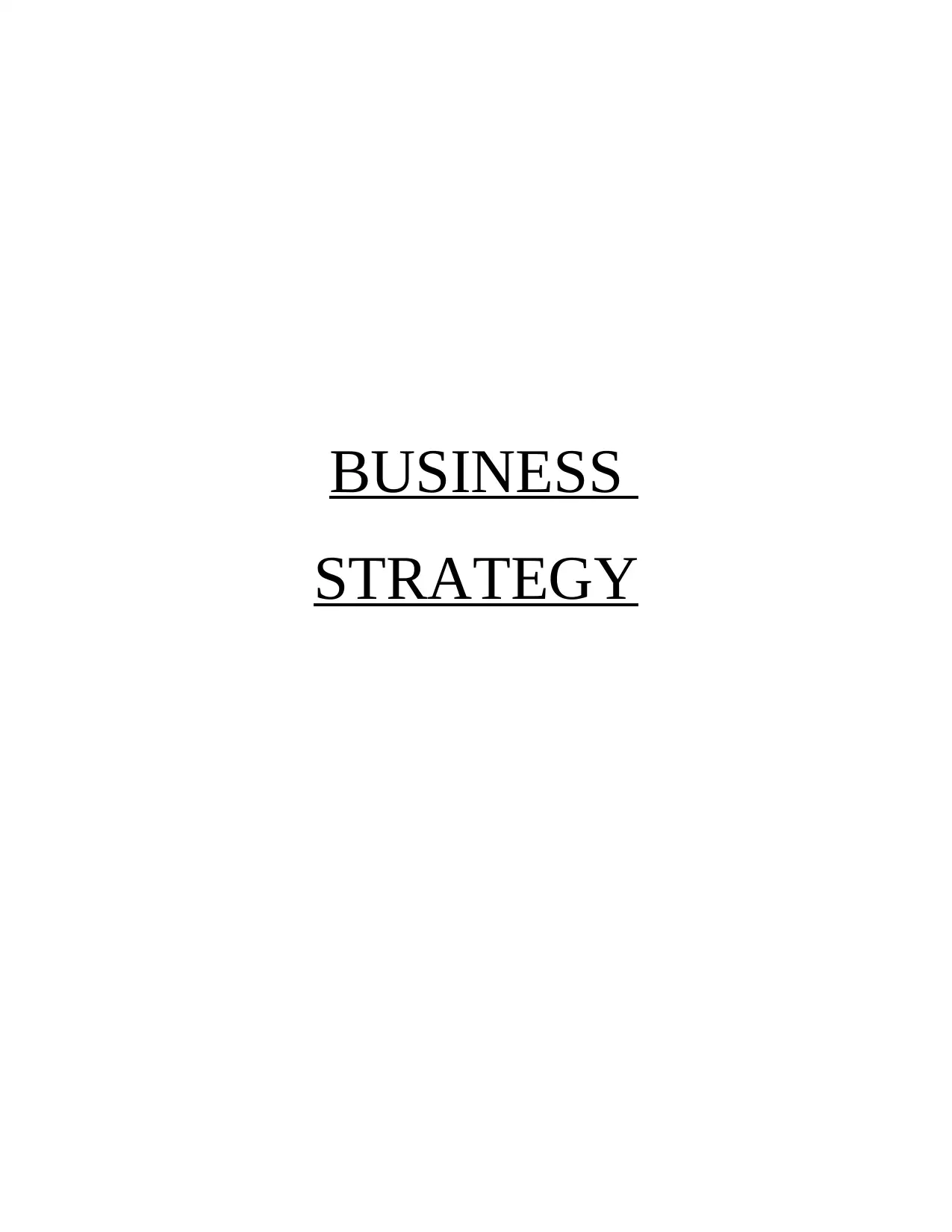
BUSINESS
STRATEGY
STRATEGY
Paraphrase This Document
Need a fresh take? Get an instant paraphrase of this document with our AI Paraphraser
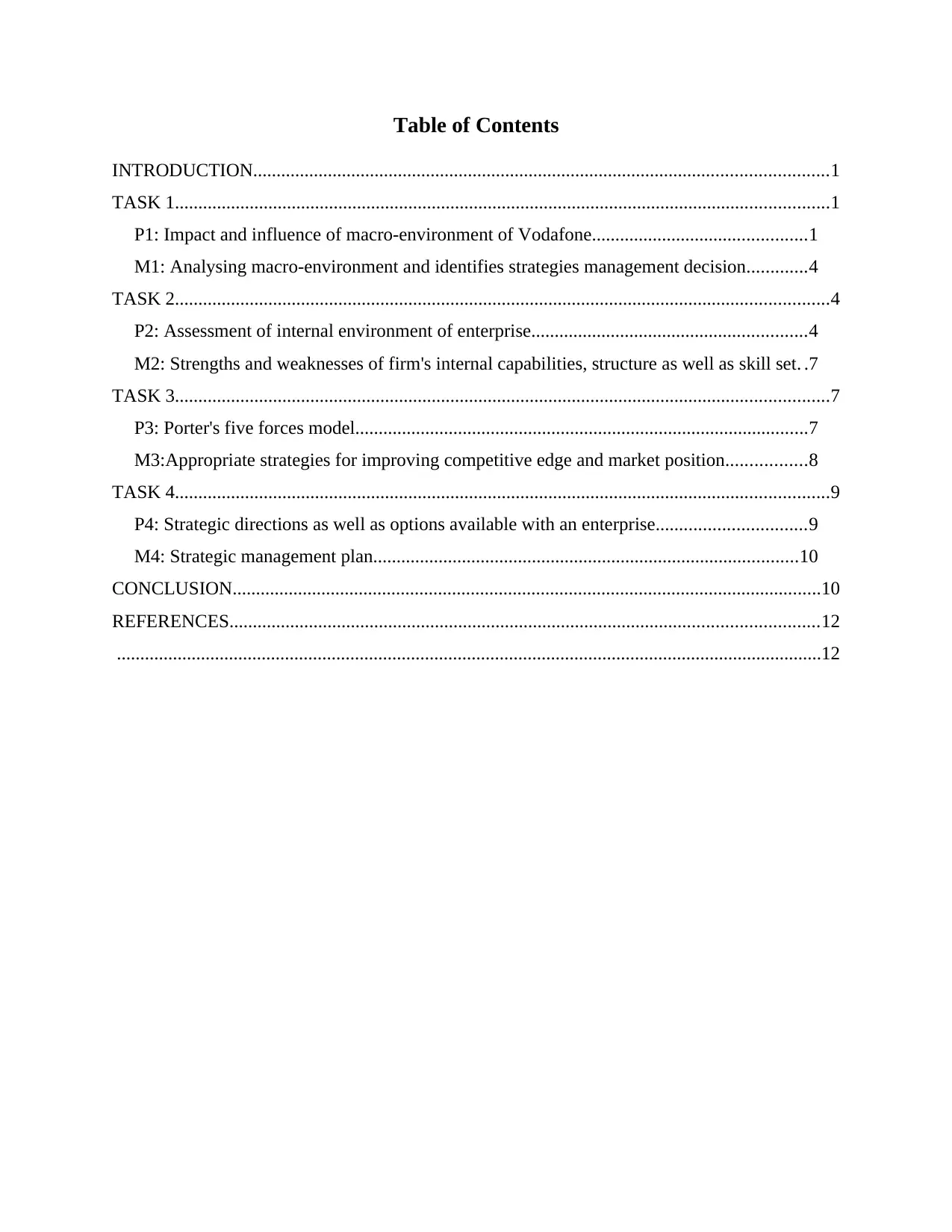
Table of Contents
INTRODUCTION...........................................................................................................................1
TASK 1............................................................................................................................................1
P1: Impact and influence of macro-environment of Vodafone..............................................1
M1: Analysing macro-environment and identifies strategies management decision.............4
TASK 2............................................................................................................................................4
P2: Assessment of internal environment of enterprise...........................................................4
M2: Strengths and weaknesses of firm's internal capabilities, structure as well as skill set. .7
TASK 3............................................................................................................................................7
P3: Porter's five forces model.................................................................................................7
M3:Appropriate strategies for improving competitive edge and market position.................8
TASK 4............................................................................................................................................9
P4: Strategic directions as well as options available with an enterprise................................9
M4: Strategic management plan...........................................................................................10
CONCLUSION..............................................................................................................................10
REFERENCES..............................................................................................................................12
.......................................................................................................................................................12
INTRODUCTION...........................................................................................................................1
TASK 1............................................................................................................................................1
P1: Impact and influence of macro-environment of Vodafone..............................................1
M1: Analysing macro-environment and identifies strategies management decision.............4
TASK 2............................................................................................................................................4
P2: Assessment of internal environment of enterprise...........................................................4
M2: Strengths and weaknesses of firm's internal capabilities, structure as well as skill set. .7
TASK 3............................................................................................................................................7
P3: Porter's five forces model.................................................................................................7
M3:Appropriate strategies for improving competitive edge and market position.................8
TASK 4............................................................................................................................................9
P4: Strategic directions as well as options available with an enterprise................................9
M4: Strategic management plan...........................................................................................10
CONCLUSION..............................................................................................................................10
REFERENCES..............................................................................................................................12
.......................................................................................................................................................12

⊘ This is a preview!⊘
Do you want full access?
Subscribe today to unlock all pages.

Trusted by 1+ million students worldwide
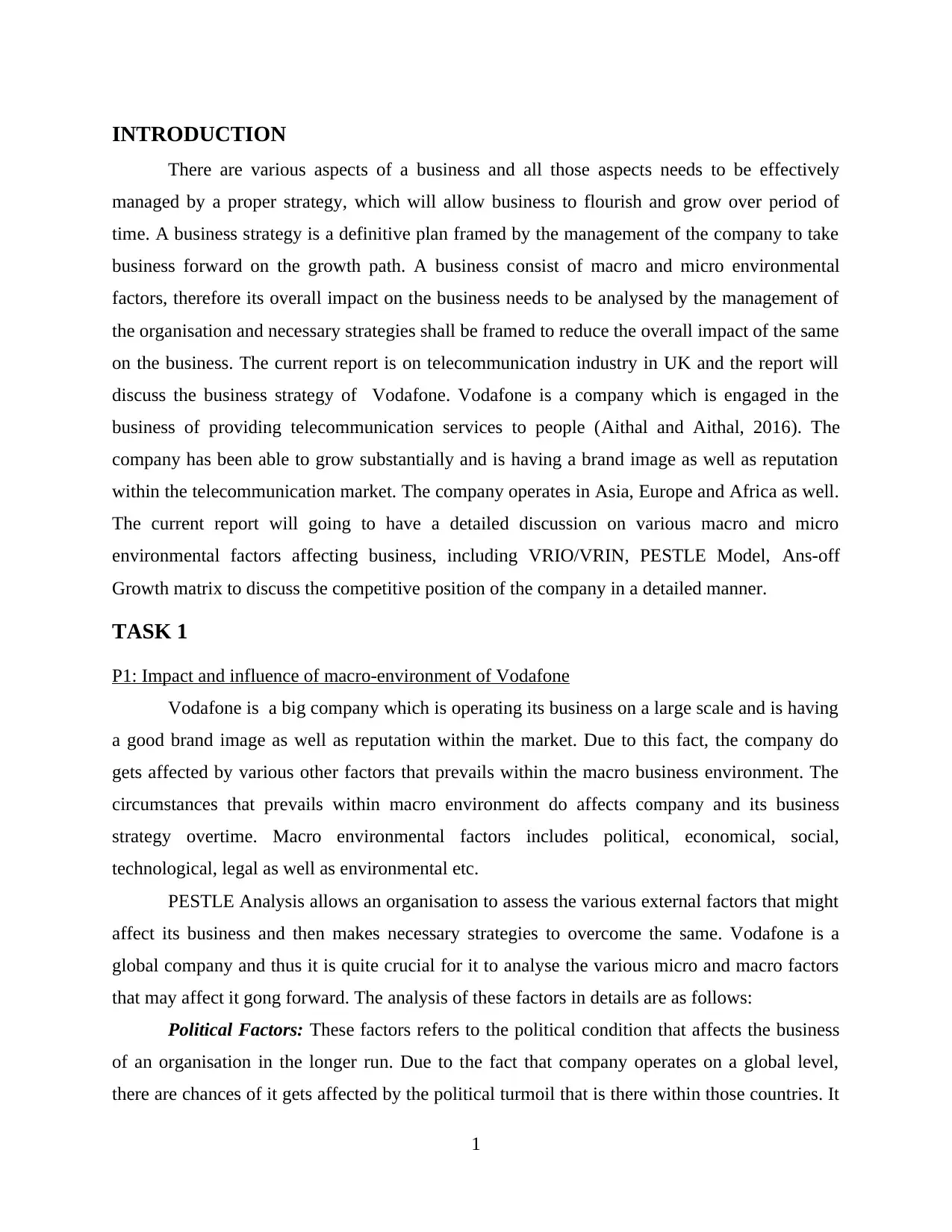
INTRODUCTION
There are various aspects of a business and all those aspects needs to be effectively
managed by a proper strategy, which will allow business to flourish and grow over period of
time. A business strategy is a definitive plan framed by the management of the company to take
business forward on the growth path. A business consist of macro and micro environmental
factors, therefore its overall impact on the business needs to be analysed by the management of
the organisation and necessary strategies shall be framed to reduce the overall impact of the same
on the business. The current report is on telecommunication industry in UK and the report will
discuss the business strategy of Vodafone. Vodafone is a company which is engaged in the
business of providing telecommunication services to people (Aithal and Aithal, 2016). The
company has been able to grow substantially and is having a brand image as well as reputation
within the telecommunication market. The company operates in Asia, Europe and Africa as well.
The current report will going to have a detailed discussion on various macro and micro
environmental factors affecting business, including VRIO/VRIN, PESTLE Model, Ans-off
Growth matrix to discuss the competitive position of the company in a detailed manner.
TASK 1
P1: Impact and influence of macro-environment of Vodafone
Vodafone is a big company which is operating its business on a large scale and is having
a good brand image as well as reputation within the market. Due to this fact, the company do
gets affected by various other factors that prevails within the macro business environment. The
circumstances that prevails within macro environment do affects company and its business
strategy overtime. Macro environmental factors includes political, economical, social,
technological, legal as well as environmental etc.
PESTLE Analysis allows an organisation to assess the various external factors that might
affect its business and then makes necessary strategies to overcome the same. Vodafone is a
global company and thus it is quite crucial for it to analyse the various micro and macro factors
that may affect it gong forward. The analysis of these factors in details are as follows:
Political Factors: These factors refers to the political condition that affects the business
of an organisation in the longer run. Due to the fact that company operates on a global level,
there are chances of it gets affected by the political turmoil that is there within those countries. It
1
There are various aspects of a business and all those aspects needs to be effectively
managed by a proper strategy, which will allow business to flourish and grow over period of
time. A business strategy is a definitive plan framed by the management of the company to take
business forward on the growth path. A business consist of macro and micro environmental
factors, therefore its overall impact on the business needs to be analysed by the management of
the organisation and necessary strategies shall be framed to reduce the overall impact of the same
on the business. The current report is on telecommunication industry in UK and the report will
discuss the business strategy of Vodafone. Vodafone is a company which is engaged in the
business of providing telecommunication services to people (Aithal and Aithal, 2016). The
company has been able to grow substantially and is having a brand image as well as reputation
within the telecommunication market. The company operates in Asia, Europe and Africa as well.
The current report will going to have a detailed discussion on various macro and micro
environmental factors affecting business, including VRIO/VRIN, PESTLE Model, Ans-off
Growth matrix to discuss the competitive position of the company in a detailed manner.
TASK 1
P1: Impact and influence of macro-environment of Vodafone
Vodafone is a big company which is operating its business on a large scale and is having
a good brand image as well as reputation within the market. Due to this fact, the company do
gets affected by various other factors that prevails within the macro business environment. The
circumstances that prevails within macro environment do affects company and its business
strategy overtime. Macro environmental factors includes political, economical, social,
technological, legal as well as environmental etc.
PESTLE Analysis allows an organisation to assess the various external factors that might
affect its business and then makes necessary strategies to overcome the same. Vodafone is a
global company and thus it is quite crucial for it to analyse the various micro and macro factors
that may affect it gong forward. The analysis of these factors in details are as follows:
Political Factors: These factors refers to the political condition that affects the business
of an organisation in the longer run. Due to the fact that company operates on a global level,
there are chances of it gets affected by the political turmoil that is there within those countries. It
1
Paraphrase This Document
Need a fresh take? Get an instant paraphrase of this document with our AI Paraphraser
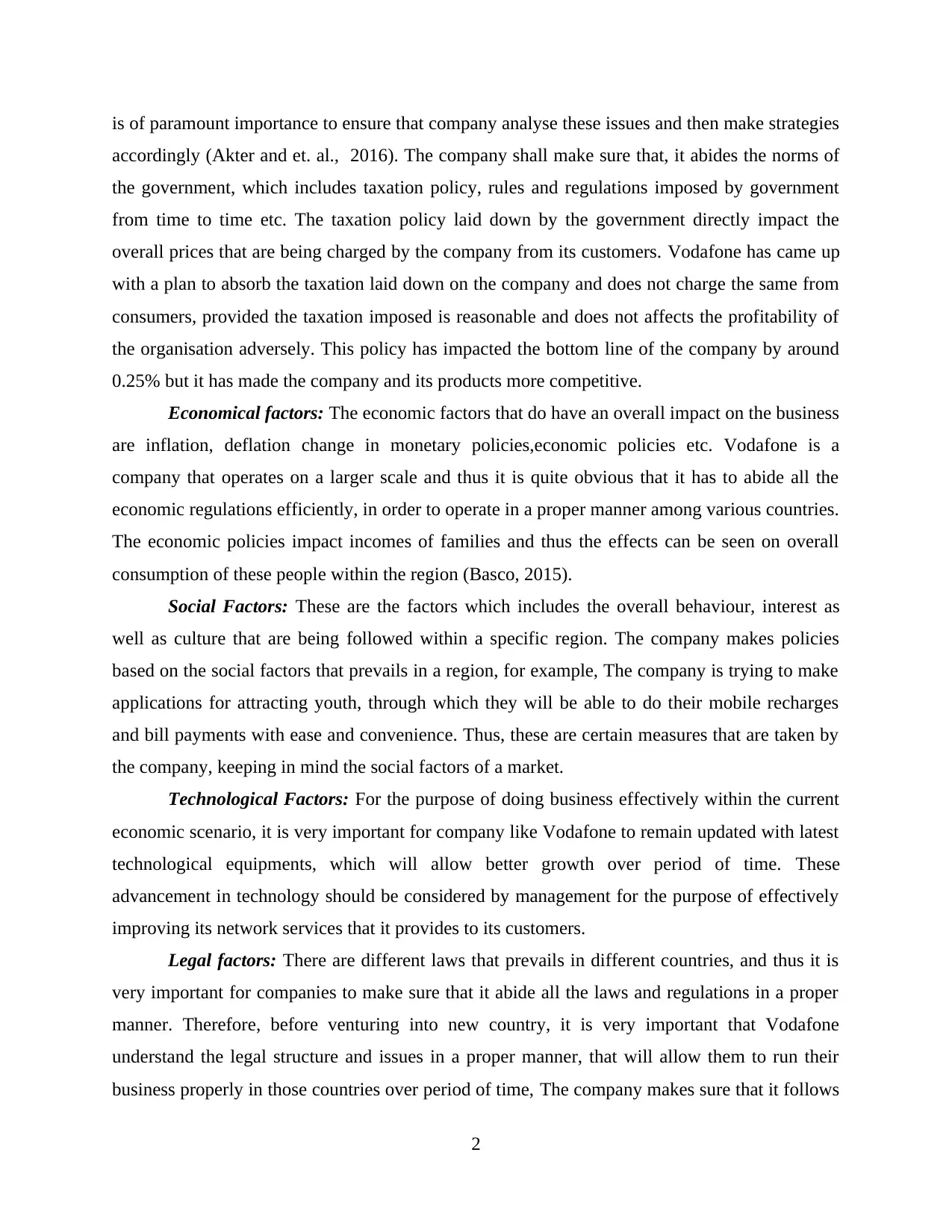
is of paramount importance to ensure that company analyse these issues and then make strategies
accordingly (Akter and et. al., 2016). The company shall make sure that, it abides the norms of
the government, which includes taxation policy, rules and regulations imposed by government
from time to time etc. The taxation policy laid down by the government directly impact the
overall prices that are being charged by the company from its customers. Vodafone has came up
with a plan to absorb the taxation laid down on the company and does not charge the same from
consumers, provided the taxation imposed is reasonable and does not affects the profitability of
the organisation adversely. This policy has impacted the bottom line of the company by around
0.25% but it has made the company and its products more competitive.
Economical factors: The economic factors that do have an overall impact on the business
are inflation, deflation change in monetary policies,economic policies etc. Vodafone is a
company that operates on a larger scale and thus it is quite obvious that it has to abide all the
economic regulations efficiently, in order to operate in a proper manner among various countries.
The economic policies impact incomes of families and thus the effects can be seen on overall
consumption of these people within the region (Basco, 2015).
Social Factors: These are the factors which includes the overall behaviour, interest as
well as culture that are being followed within a specific region. The company makes policies
based on the social factors that prevails in a region, for example, The company is trying to make
applications for attracting youth, through which they will be able to do their mobile recharges
and bill payments with ease and convenience. Thus, these are certain measures that are taken by
the company, keeping in mind the social factors of a market.
Technological Factors: For the purpose of doing business effectively within the current
economic scenario, it is very important for company like Vodafone to remain updated with latest
technological equipments, which will allow better growth over period of time. These
advancement in technology should be considered by management for the purpose of effectively
improving its network services that it provides to its customers.
Legal factors: There are different laws that prevails in different countries, and thus it is
very important for companies to make sure that it abide all the laws and regulations in a proper
manner. Therefore, before venturing into new country, it is very important that Vodafone
understand the legal structure and issues in a proper manner, that will allow them to run their
business properly in those countries over period of time, The company makes sure that it follows
2
accordingly (Akter and et. al., 2016). The company shall make sure that, it abides the norms of
the government, which includes taxation policy, rules and regulations imposed by government
from time to time etc. The taxation policy laid down by the government directly impact the
overall prices that are being charged by the company from its customers. Vodafone has came up
with a plan to absorb the taxation laid down on the company and does not charge the same from
consumers, provided the taxation imposed is reasonable and does not affects the profitability of
the organisation adversely. This policy has impacted the bottom line of the company by around
0.25% but it has made the company and its products more competitive.
Economical factors: The economic factors that do have an overall impact on the business
are inflation, deflation change in monetary policies,economic policies etc. Vodafone is a
company that operates on a larger scale and thus it is quite obvious that it has to abide all the
economic regulations efficiently, in order to operate in a proper manner among various countries.
The economic policies impact incomes of families and thus the effects can be seen on overall
consumption of these people within the region (Basco, 2015).
Social Factors: These are the factors which includes the overall behaviour, interest as
well as culture that are being followed within a specific region. The company makes policies
based on the social factors that prevails in a region, for example, The company is trying to make
applications for attracting youth, through which they will be able to do their mobile recharges
and bill payments with ease and convenience. Thus, these are certain measures that are taken by
the company, keeping in mind the social factors of a market.
Technological Factors: For the purpose of doing business effectively within the current
economic scenario, it is very important for company like Vodafone to remain updated with latest
technological equipments, which will allow better growth over period of time. These
advancement in technology should be considered by management for the purpose of effectively
improving its network services that it provides to its customers.
Legal factors: There are different laws that prevails in different countries, and thus it is
very important for companies to make sure that it abide all the laws and regulations in a proper
manner. Therefore, before venturing into new country, it is very important that Vodafone
understand the legal structure and issues in a proper manner, that will allow them to run their
business properly in those countries over period of time, The company makes sure that it follows
2
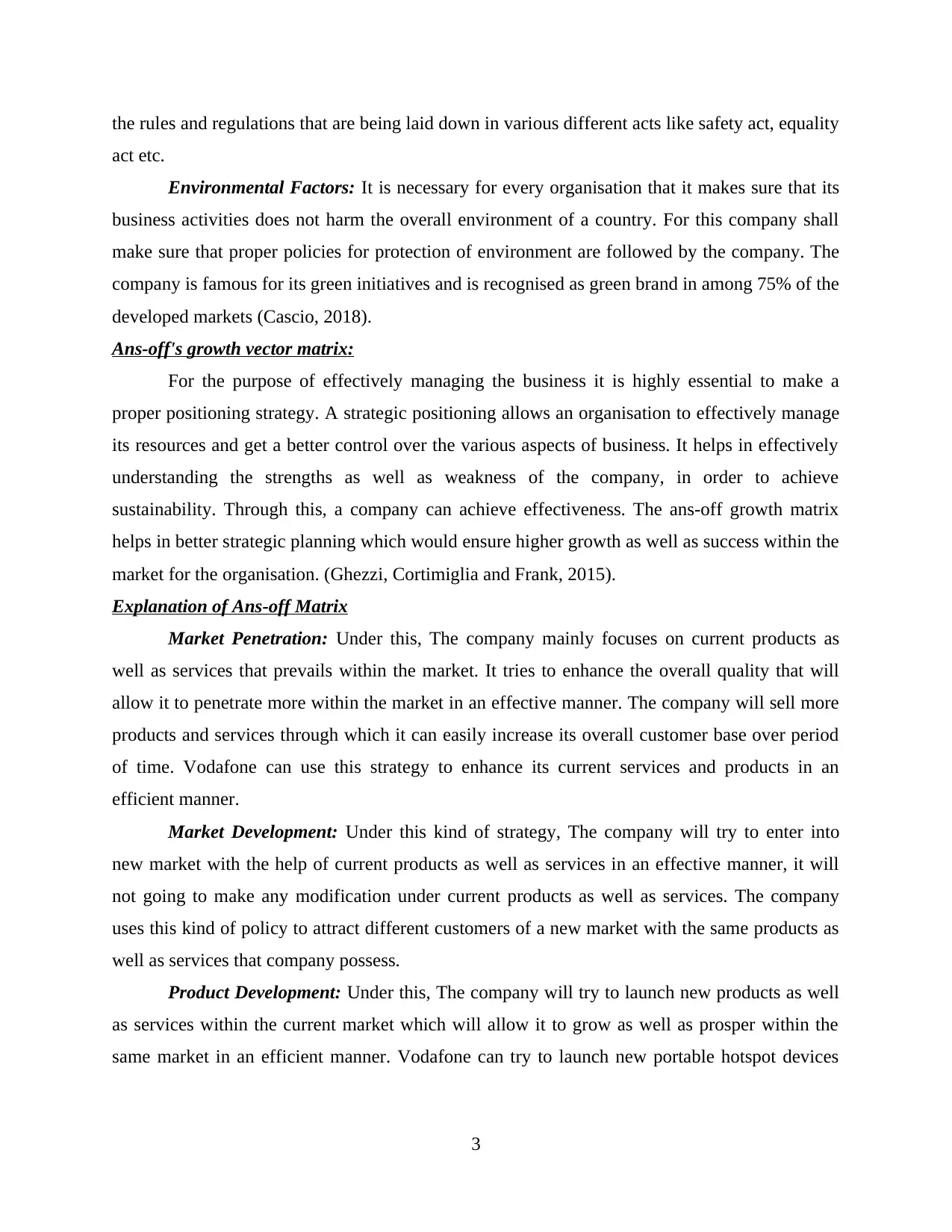
the rules and regulations that are being laid down in various different acts like safety act, equality
act etc.
Environmental Factors: It is necessary for every organisation that it makes sure that its
business activities does not harm the overall environment of a country. For this company shall
make sure that proper policies for protection of environment are followed by the company. The
company is famous for its green initiatives and is recognised as green brand in among 75% of the
developed markets (Cascio, 2018).
Ans-off's growth vector matrix:
For the purpose of effectively managing the business it is highly essential to make a
proper positioning strategy. A strategic positioning allows an organisation to effectively manage
its resources and get a better control over the various aspects of business. It helps in effectively
understanding the strengths as well as weakness of the company, in order to achieve
sustainability. Through this, a company can achieve effectiveness. The ans-off growth matrix
helps in better strategic planning which would ensure higher growth as well as success within the
market for the organisation. (Ghezzi, Cortimiglia and Frank, 2015).
Explanation of Ans-off Matrix
Market Penetration: Under this, The company mainly focuses on current products as
well as services that prevails within the market. It tries to enhance the overall quality that will
allow it to penetrate more within the market in an effective manner. The company will sell more
products and services through which it can easily increase its overall customer base over period
of time. Vodafone can use this strategy to enhance its current services and products in an
efficient manner.
Market Development: Under this kind of strategy, The company will try to enter into
new market with the help of current products as well as services in an effective manner, it will
not going to make any modification under current products as well as services. The company
uses this kind of policy to attract different customers of a new market with the same products as
well as services that company possess.
Product Development: Under this, The company will try to launch new products as well
as services within the current market which will allow it to grow as well as prosper within the
same market in an efficient manner. Vodafone can try to launch new portable hotspot devices
3
act etc.
Environmental Factors: It is necessary for every organisation that it makes sure that its
business activities does not harm the overall environment of a country. For this company shall
make sure that proper policies for protection of environment are followed by the company. The
company is famous for its green initiatives and is recognised as green brand in among 75% of the
developed markets (Cascio, 2018).
Ans-off's growth vector matrix:
For the purpose of effectively managing the business it is highly essential to make a
proper positioning strategy. A strategic positioning allows an organisation to effectively manage
its resources and get a better control over the various aspects of business. It helps in effectively
understanding the strengths as well as weakness of the company, in order to achieve
sustainability. Through this, a company can achieve effectiveness. The ans-off growth matrix
helps in better strategic planning which would ensure higher growth as well as success within the
market for the organisation. (Ghezzi, Cortimiglia and Frank, 2015).
Explanation of Ans-off Matrix
Market Penetration: Under this, The company mainly focuses on current products as
well as services that prevails within the market. It tries to enhance the overall quality that will
allow it to penetrate more within the market in an effective manner. The company will sell more
products and services through which it can easily increase its overall customer base over period
of time. Vodafone can use this strategy to enhance its current services and products in an
efficient manner.
Market Development: Under this kind of strategy, The company will try to enter into
new market with the help of current products as well as services in an effective manner, it will
not going to make any modification under current products as well as services. The company
uses this kind of policy to attract different customers of a new market with the same products as
well as services that company possess.
Product Development: Under this, The company will try to launch new products as well
as services within the current market which will allow it to grow as well as prosper within the
same market in an efficient manner. Vodafone can try to launch new portable hotspot devices
3
⊘ This is a preview!⊘
Do you want full access?
Subscribe today to unlock all pages.

Trusted by 1+ million students worldwide
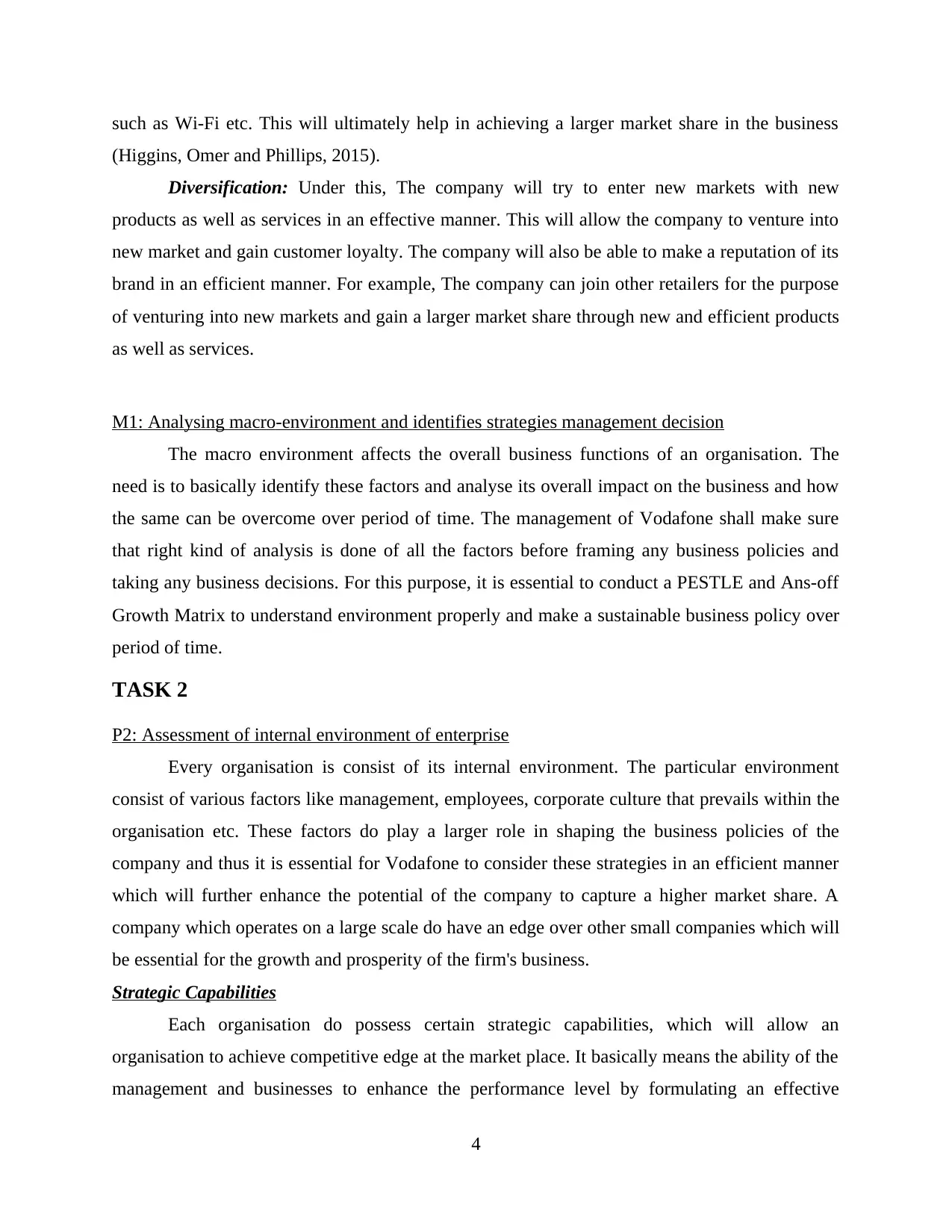
such as Wi-Fi etc. This will ultimately help in achieving a larger market share in the business
(Higgins, Omer and Phillips, 2015).
Diversification: Under this, The company will try to enter new markets with new
products as well as services in an effective manner. This will allow the company to venture into
new market and gain customer loyalty. The company will also be able to make a reputation of its
brand in an efficient manner. For example, The company can join other retailers for the purpose
of venturing into new markets and gain a larger market share through new and efficient products
as well as services.
M1: Analysing macro-environment and identifies strategies management decision
The macro environment affects the overall business functions of an organisation. The
need is to basically identify these factors and analyse its overall impact on the business and how
the same can be overcome over period of time. The management of Vodafone shall make sure
that right kind of analysis is done of all the factors before framing any business policies and
taking any business decisions. For this purpose, it is essential to conduct a PESTLE and Ans-off
Growth Matrix to understand environment properly and make a sustainable business policy over
period of time.
TASK 2
P2: Assessment of internal environment of enterprise
Every organisation is consist of its internal environment. The particular environment
consist of various factors like management, employees, corporate culture that prevails within the
organisation etc. These factors do play a larger role in shaping the business policies of the
company and thus it is essential for Vodafone to consider these strategies in an efficient manner
which will further enhance the potential of the company to capture a higher market share. A
company which operates on a large scale do have an edge over other small companies which will
be essential for the growth and prosperity of the firm's business.
Strategic Capabilities
Each organisation do possess certain strategic capabilities, which will allow an
organisation to achieve competitive edge at the market place. It basically means the ability of the
management and businesses to enhance the performance level by formulating an effective
4
(Higgins, Omer and Phillips, 2015).
Diversification: Under this, The company will try to enter new markets with new
products as well as services in an effective manner. This will allow the company to venture into
new market and gain customer loyalty. The company will also be able to make a reputation of its
brand in an efficient manner. For example, The company can join other retailers for the purpose
of venturing into new markets and gain a larger market share through new and efficient products
as well as services.
M1: Analysing macro-environment and identifies strategies management decision
The macro environment affects the overall business functions of an organisation. The
need is to basically identify these factors and analyse its overall impact on the business and how
the same can be overcome over period of time. The management of Vodafone shall make sure
that right kind of analysis is done of all the factors before framing any business policies and
taking any business decisions. For this purpose, it is essential to conduct a PESTLE and Ans-off
Growth Matrix to understand environment properly and make a sustainable business policy over
period of time.
TASK 2
P2: Assessment of internal environment of enterprise
Every organisation is consist of its internal environment. The particular environment
consist of various factors like management, employees, corporate culture that prevails within the
organisation etc. These factors do play a larger role in shaping the business policies of the
company and thus it is essential for Vodafone to consider these strategies in an efficient manner
which will further enhance the potential of the company to capture a higher market share. A
company which operates on a large scale do have an edge over other small companies which will
be essential for the growth and prosperity of the firm's business.
Strategic Capabilities
Each organisation do possess certain strategic capabilities, which will allow an
organisation to achieve competitive edge at the market place. It basically means the ability of the
management and businesses to enhance the performance level by formulating an effective
4
Paraphrase This Document
Need a fresh take? Get an instant paraphrase of this document with our AI Paraphraser
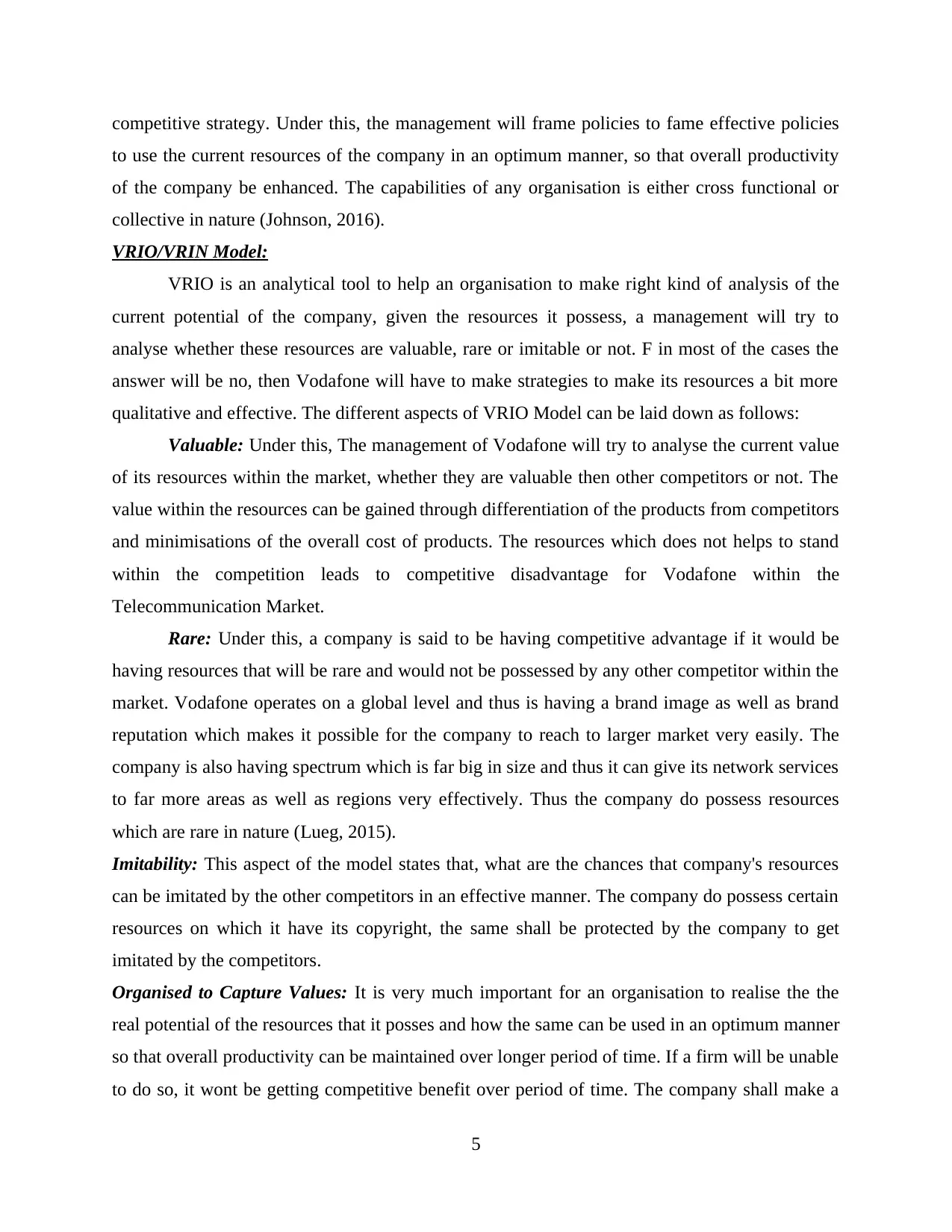
competitive strategy. Under this, the management will frame policies to fame effective policies
to use the current resources of the company in an optimum manner, so that overall productivity
of the company be enhanced. The capabilities of any organisation is either cross functional or
collective in nature (Johnson, 2016).
VRIO/VRIN Model:
VRIO is an analytical tool to help an organisation to make right kind of analysis of the
current potential of the company, given the resources it possess, a management will try to
analyse whether these resources are valuable, rare or imitable or not. F in most of the cases the
answer will be no, then Vodafone will have to make strategies to make its resources a bit more
qualitative and effective. The different aspects of VRIO Model can be laid down as follows:
Valuable: Under this, The management of Vodafone will try to analyse the current value
of its resources within the market, whether they are valuable then other competitors or not. The
value within the resources can be gained through differentiation of the products from competitors
and minimisations of the overall cost of products. The resources which does not helps to stand
within the competition leads to competitive disadvantage for Vodafone within the
Telecommunication Market.
Rare: Under this, a company is said to be having competitive advantage if it would be
having resources that will be rare and would not be possessed by any other competitor within the
market. Vodafone operates on a global level and thus is having a brand image as well as brand
reputation which makes it possible for the company to reach to larger market very easily. The
company is also having spectrum which is far big in size and thus it can give its network services
to far more areas as well as regions very effectively. Thus the company do possess resources
which are rare in nature (Lueg, 2015).
Imitability: This aspect of the model states that, what are the chances that company's resources
can be imitated by the other competitors in an effective manner. The company do possess certain
resources on which it have its copyright, the same shall be protected by the company to get
imitated by the competitors.
Organised to Capture Values: It is very much important for an organisation to realise the the
real potential of the resources that it posses and how the same can be used in an optimum manner
so that overall productivity can be maintained over longer period of time. If a firm will be unable
to do so, it wont be getting competitive benefit over period of time. The company shall make a
5
to use the current resources of the company in an optimum manner, so that overall productivity
of the company be enhanced. The capabilities of any organisation is either cross functional or
collective in nature (Johnson, 2016).
VRIO/VRIN Model:
VRIO is an analytical tool to help an organisation to make right kind of analysis of the
current potential of the company, given the resources it possess, a management will try to
analyse whether these resources are valuable, rare or imitable or not. F in most of the cases the
answer will be no, then Vodafone will have to make strategies to make its resources a bit more
qualitative and effective. The different aspects of VRIO Model can be laid down as follows:
Valuable: Under this, The management of Vodafone will try to analyse the current value
of its resources within the market, whether they are valuable then other competitors or not. The
value within the resources can be gained through differentiation of the products from competitors
and minimisations of the overall cost of products. The resources which does not helps to stand
within the competition leads to competitive disadvantage for Vodafone within the
Telecommunication Market.
Rare: Under this, a company is said to be having competitive advantage if it would be
having resources that will be rare and would not be possessed by any other competitor within the
market. Vodafone operates on a global level and thus is having a brand image as well as brand
reputation which makes it possible for the company to reach to larger market very easily. The
company is also having spectrum which is far big in size and thus it can give its network services
to far more areas as well as regions very effectively. Thus the company do possess resources
which are rare in nature (Lueg, 2015).
Imitability: This aspect of the model states that, what are the chances that company's resources
can be imitated by the other competitors in an effective manner. The company do possess certain
resources on which it have its copyright, the same shall be protected by the company to get
imitated by the competitors.
Organised to Capture Values: It is very much important for an organisation to realise the the
real potential of the resources that it posses and how the same can be used in an optimum manner
so that overall productivity can be maintained over longer period of time. If a firm will be unable
to do so, it wont be getting competitive benefit over period of time. The company shall make a
5
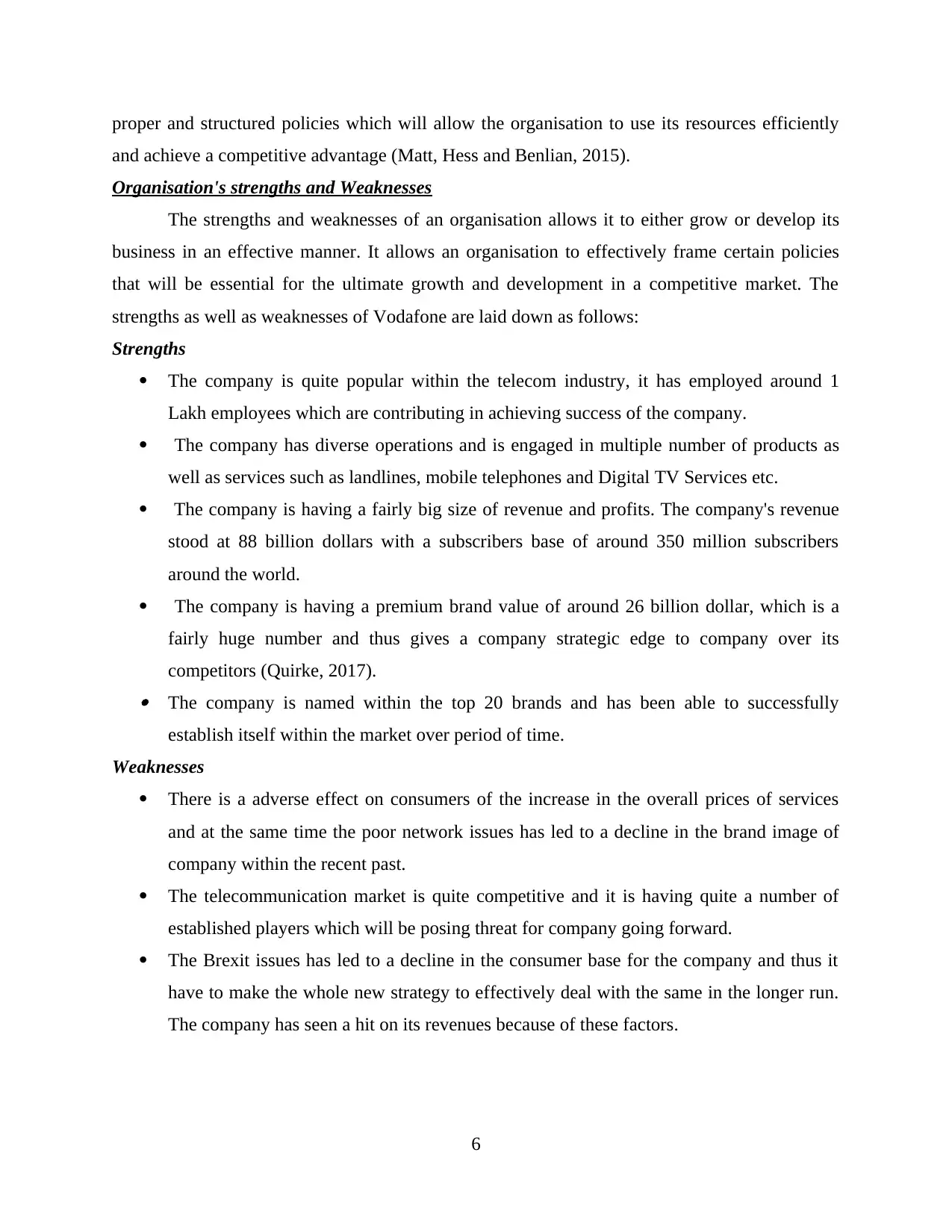
proper and structured policies which will allow the organisation to use its resources efficiently
and achieve a competitive advantage (Matt, Hess and Benlian, 2015).
Organisation's strengths and Weaknesses
The strengths and weaknesses of an organisation allows it to either grow or develop its
business in an effective manner. It allows an organisation to effectively frame certain policies
that will be essential for the ultimate growth and development in a competitive market. The
strengths as well as weaknesses of Vodafone are laid down as follows:
Strengths
The company is quite popular within the telecom industry, it has employed around 1
Lakh employees which are contributing in achieving success of the company.
The company has diverse operations and is engaged in multiple number of products as
well as services such as landlines, mobile telephones and Digital TV Services etc.
The company is having a fairly big size of revenue and profits. The company's revenue
stood at 88 billion dollars with a subscribers base of around 350 million subscribers
around the world.
The company is having a premium brand value of around 26 billion dollar, which is a
fairly huge number and thus gives a company strategic edge to company over its
competitors (Quirke, 2017). The company is named within the top 20 brands and has been able to successfully
establish itself within the market over period of time.
Weaknesses
There is a adverse effect on consumers of the increase in the overall prices of services
and at the same time the poor network issues has led to a decline in the brand image of
company within the recent past.
The telecommunication market is quite competitive and it is having quite a number of
established players which will be posing threat for company going forward.
The Brexit issues has led to a decline in the consumer base for the company and thus it
have to make the whole new strategy to effectively deal with the same in the longer run.
The company has seen a hit on its revenues because of these factors.
6
and achieve a competitive advantage (Matt, Hess and Benlian, 2015).
Organisation's strengths and Weaknesses
The strengths and weaknesses of an organisation allows it to either grow or develop its
business in an effective manner. It allows an organisation to effectively frame certain policies
that will be essential for the ultimate growth and development in a competitive market. The
strengths as well as weaknesses of Vodafone are laid down as follows:
Strengths
The company is quite popular within the telecom industry, it has employed around 1
Lakh employees which are contributing in achieving success of the company.
The company has diverse operations and is engaged in multiple number of products as
well as services such as landlines, mobile telephones and Digital TV Services etc.
The company is having a fairly big size of revenue and profits. The company's revenue
stood at 88 billion dollars with a subscribers base of around 350 million subscribers
around the world.
The company is having a premium brand value of around 26 billion dollar, which is a
fairly huge number and thus gives a company strategic edge to company over its
competitors (Quirke, 2017). The company is named within the top 20 brands and has been able to successfully
establish itself within the market over period of time.
Weaknesses
There is a adverse effect on consumers of the increase in the overall prices of services
and at the same time the poor network issues has led to a decline in the brand image of
company within the recent past.
The telecommunication market is quite competitive and it is having quite a number of
established players which will be posing threat for company going forward.
The Brexit issues has led to a decline in the consumer base for the company and thus it
have to make the whole new strategy to effectively deal with the same in the longer run.
The company has seen a hit on its revenues because of these factors.
6
⊘ This is a preview!⊘
Do you want full access?
Subscribe today to unlock all pages.

Trusted by 1+ million students worldwide
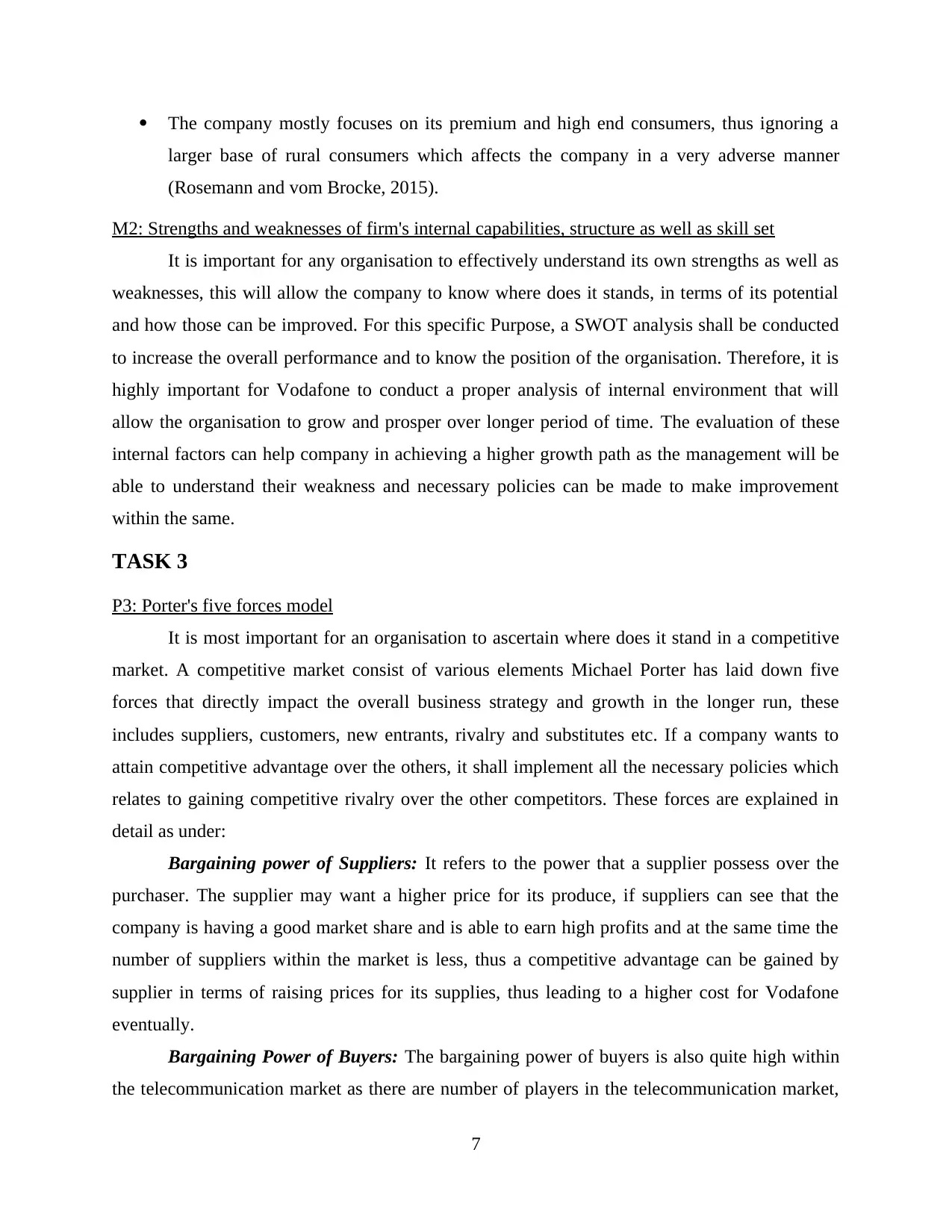
The company mostly focuses on its premium and high end consumers, thus ignoring a
larger base of rural consumers which affects the company in a very adverse manner
(Rosemann and vom Brocke, 2015).
M2: Strengths and weaknesses of firm's internal capabilities, structure as well as skill set
It is important for any organisation to effectively understand its own strengths as well as
weaknesses, this will allow the company to know where does it stands, in terms of its potential
and how those can be improved. For this specific Purpose, a SWOT analysis shall be conducted
to increase the overall performance and to know the position of the organisation. Therefore, it is
highly important for Vodafone to conduct a proper analysis of internal environment that will
allow the organisation to grow and prosper over longer period of time. The evaluation of these
internal factors can help company in achieving a higher growth path as the management will be
able to understand their weakness and necessary policies can be made to make improvement
within the same.
TASK 3
P3: Porter's five forces model
It is most important for an organisation to ascertain where does it stand in a competitive
market. A competitive market consist of various elements Michael Porter has laid down five
forces that directly impact the overall business strategy and growth in the longer run, these
includes suppliers, customers, new entrants, rivalry and substitutes etc. If a company wants to
attain competitive advantage over the others, it shall implement all the necessary policies which
relates to gaining competitive rivalry over the other competitors. These forces are explained in
detail as under:
Bargaining power of Suppliers: It refers to the power that a supplier possess over the
purchaser. The supplier may want a higher price for its produce, if suppliers can see that the
company is having a good market share and is able to earn high profits and at the same time the
number of suppliers within the market is less, thus a competitive advantage can be gained by
supplier in terms of raising prices for its supplies, thus leading to a higher cost for Vodafone
eventually.
Bargaining Power of Buyers: The bargaining power of buyers is also quite high within
the telecommunication market as there are number of players in the telecommunication market,
7
larger base of rural consumers which affects the company in a very adverse manner
(Rosemann and vom Brocke, 2015).
M2: Strengths and weaknesses of firm's internal capabilities, structure as well as skill set
It is important for any organisation to effectively understand its own strengths as well as
weaknesses, this will allow the company to know where does it stands, in terms of its potential
and how those can be improved. For this specific Purpose, a SWOT analysis shall be conducted
to increase the overall performance and to know the position of the organisation. Therefore, it is
highly important for Vodafone to conduct a proper analysis of internal environment that will
allow the organisation to grow and prosper over longer period of time. The evaluation of these
internal factors can help company in achieving a higher growth path as the management will be
able to understand their weakness and necessary policies can be made to make improvement
within the same.
TASK 3
P3: Porter's five forces model
It is most important for an organisation to ascertain where does it stand in a competitive
market. A competitive market consist of various elements Michael Porter has laid down five
forces that directly impact the overall business strategy and growth in the longer run, these
includes suppliers, customers, new entrants, rivalry and substitutes etc. If a company wants to
attain competitive advantage over the others, it shall implement all the necessary policies which
relates to gaining competitive rivalry over the other competitors. These forces are explained in
detail as under:
Bargaining power of Suppliers: It refers to the power that a supplier possess over the
purchaser. The supplier may want a higher price for its produce, if suppliers can see that the
company is having a good market share and is able to earn high profits and at the same time the
number of suppliers within the market is less, thus a competitive advantage can be gained by
supplier in terms of raising prices for its supplies, thus leading to a higher cost for Vodafone
eventually.
Bargaining Power of Buyers: The bargaining power of buyers is also quite high within
the telecommunication market as there are number of players in the telecommunication market,
7
Paraphrase This Document
Need a fresh take? Get an instant paraphrase of this document with our AI Paraphraser
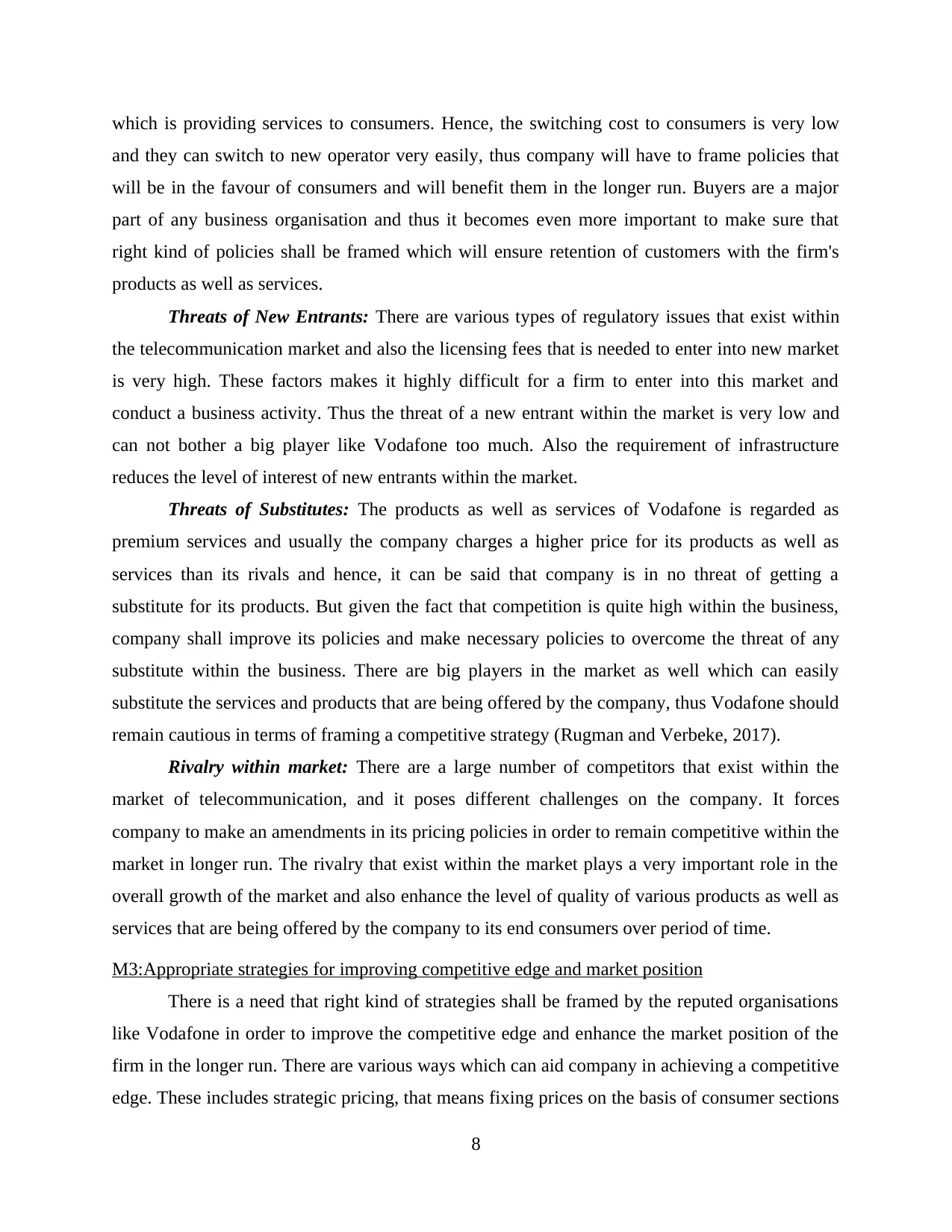
which is providing services to consumers. Hence, the switching cost to consumers is very low
and they can switch to new operator very easily, thus company will have to frame policies that
will be in the favour of consumers and will benefit them in the longer run. Buyers are a major
part of any business organisation and thus it becomes even more important to make sure that
right kind of policies shall be framed which will ensure retention of customers with the firm's
products as well as services.
Threats of New Entrants: There are various types of regulatory issues that exist within
the telecommunication market and also the licensing fees that is needed to enter into new market
is very high. These factors makes it highly difficult for a firm to enter into this market and
conduct a business activity. Thus the threat of a new entrant within the market is very low and
can not bother a big player like Vodafone too much. Also the requirement of infrastructure
reduces the level of interest of new entrants within the market.
Threats of Substitutes: The products as well as services of Vodafone is regarded as
premium services and usually the company charges a higher price for its products as well as
services than its rivals and hence, it can be said that company is in no threat of getting a
substitute for its products. But given the fact that competition is quite high within the business,
company shall improve its policies and make necessary policies to overcome the threat of any
substitute within the business. There are big players in the market as well which can easily
substitute the services and products that are being offered by the company, thus Vodafone should
remain cautious in terms of framing a competitive strategy (Rugman and Verbeke, 2017).
Rivalry within market: There are a large number of competitors that exist within the
market of telecommunication, and it poses different challenges on the company. It forces
company to make an amendments in its pricing policies in order to remain competitive within the
market in longer run. The rivalry that exist within the market plays a very important role in the
overall growth of the market and also enhance the level of quality of various products as well as
services that are being offered by the company to its end consumers over period of time.
M3:Appropriate strategies for improving competitive edge and market position
There is a need that right kind of strategies shall be framed by the reputed organisations
like Vodafone in order to improve the competitive edge and enhance the market position of the
firm in the longer run. There are various ways which can aid company in achieving a competitive
edge. These includes strategic pricing, that means fixing prices on the basis of consumer sections
8
and they can switch to new operator very easily, thus company will have to frame policies that
will be in the favour of consumers and will benefit them in the longer run. Buyers are a major
part of any business organisation and thus it becomes even more important to make sure that
right kind of policies shall be framed which will ensure retention of customers with the firm's
products as well as services.
Threats of New Entrants: There are various types of regulatory issues that exist within
the telecommunication market and also the licensing fees that is needed to enter into new market
is very high. These factors makes it highly difficult for a firm to enter into this market and
conduct a business activity. Thus the threat of a new entrant within the market is very low and
can not bother a big player like Vodafone too much. Also the requirement of infrastructure
reduces the level of interest of new entrants within the market.
Threats of Substitutes: The products as well as services of Vodafone is regarded as
premium services and usually the company charges a higher price for its products as well as
services than its rivals and hence, it can be said that company is in no threat of getting a
substitute for its products. But given the fact that competition is quite high within the business,
company shall improve its policies and make necessary policies to overcome the threat of any
substitute within the business. There are big players in the market as well which can easily
substitute the services and products that are being offered by the company, thus Vodafone should
remain cautious in terms of framing a competitive strategy (Rugman and Verbeke, 2017).
Rivalry within market: There are a large number of competitors that exist within the
market of telecommunication, and it poses different challenges on the company. It forces
company to make an amendments in its pricing policies in order to remain competitive within the
market in longer run. The rivalry that exist within the market plays a very important role in the
overall growth of the market and also enhance the level of quality of various products as well as
services that are being offered by the company to its end consumers over period of time.
M3:Appropriate strategies for improving competitive edge and market position
There is a need that right kind of strategies shall be framed by the reputed organisations
like Vodafone in order to improve the competitive edge and enhance the market position of the
firm in the longer run. There are various ways which can aid company in achieving a competitive
edge. These includes strategic pricing, that means fixing prices on the basis of consumer sections
8
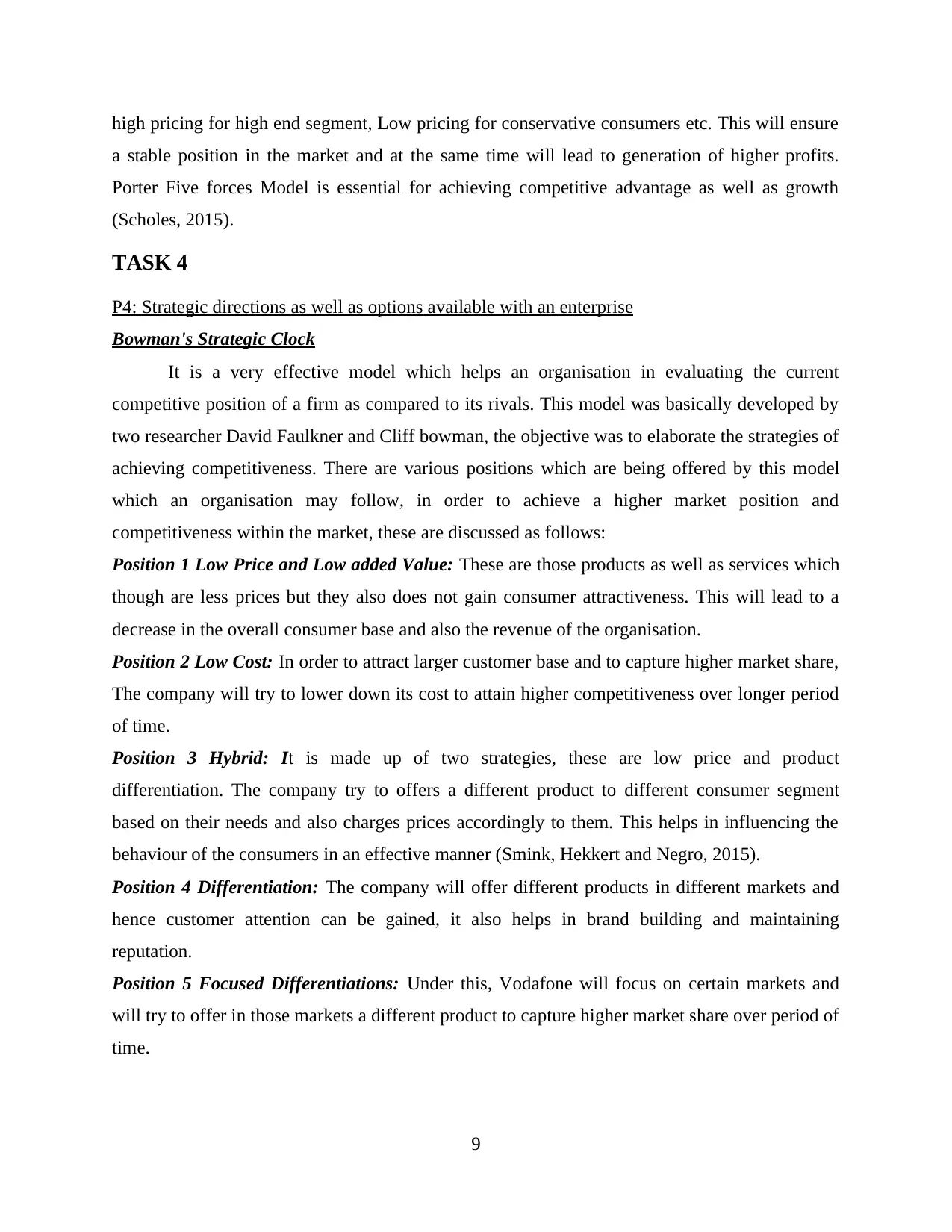
high pricing for high end segment, Low pricing for conservative consumers etc. This will ensure
a stable position in the market and at the same time will lead to generation of higher profits.
Porter Five forces Model is essential for achieving competitive advantage as well as growth
(Scholes, 2015).
TASK 4
P4: Strategic directions as well as options available with an enterprise
Bowman's Strategic Clock
It is a very effective model which helps an organisation in evaluating the current
competitive position of a firm as compared to its rivals. This model was basically developed by
two researcher David Faulkner and Cliff bowman, the objective was to elaborate the strategies of
achieving competitiveness. There are various positions which are being offered by this model
which an organisation may follow, in order to achieve a higher market position and
competitiveness within the market, these are discussed as follows:
Position 1 Low Price and Low added Value: These are those products as well as services which
though are less prices but they also does not gain consumer attractiveness. This will lead to a
decrease in the overall consumer base and also the revenue of the organisation.
Position 2 Low Cost: In order to attract larger customer base and to capture higher market share,
The company will try to lower down its cost to attain higher competitiveness over longer period
of time.
Position 3 Hybrid: It is made up of two strategies, these are low price and product
differentiation. The company try to offers a different product to different consumer segment
based on their needs and also charges prices accordingly to them. This helps in influencing the
behaviour of the consumers in an effective manner (Smink, Hekkert and Negro, 2015).
Position 4 Differentiation: The company will offer different products in different markets and
hence customer attention can be gained, it also helps in brand building and maintaining
reputation.
Position 5 Focused Differentiations: Under this, Vodafone will focus on certain markets and
will try to offer in those markets a different product to capture higher market share over period of
time.
9
a stable position in the market and at the same time will lead to generation of higher profits.
Porter Five forces Model is essential for achieving competitive advantage as well as growth
(Scholes, 2015).
TASK 4
P4: Strategic directions as well as options available with an enterprise
Bowman's Strategic Clock
It is a very effective model which helps an organisation in evaluating the current
competitive position of a firm as compared to its rivals. This model was basically developed by
two researcher David Faulkner and Cliff bowman, the objective was to elaborate the strategies of
achieving competitiveness. There are various positions which are being offered by this model
which an organisation may follow, in order to achieve a higher market position and
competitiveness within the market, these are discussed as follows:
Position 1 Low Price and Low added Value: These are those products as well as services which
though are less prices but they also does not gain consumer attractiveness. This will lead to a
decrease in the overall consumer base and also the revenue of the organisation.
Position 2 Low Cost: In order to attract larger customer base and to capture higher market share,
The company will try to lower down its cost to attain higher competitiveness over longer period
of time.
Position 3 Hybrid: It is made up of two strategies, these are low price and product
differentiation. The company try to offers a different product to different consumer segment
based on their needs and also charges prices accordingly to them. This helps in influencing the
behaviour of the consumers in an effective manner (Smink, Hekkert and Negro, 2015).
Position 4 Differentiation: The company will offer different products in different markets and
hence customer attention can be gained, it also helps in brand building and maintaining
reputation.
Position 5 Focused Differentiations: Under this, Vodafone will focus on certain markets and
will try to offer in those markets a different product to capture higher market share over period of
time.
9
⊘ This is a preview!⊘
Do you want full access?
Subscribe today to unlock all pages.

Trusted by 1+ million students worldwide
1 out of 15
Related Documents
Your All-in-One AI-Powered Toolkit for Academic Success.
+13062052269
info@desklib.com
Available 24*7 on WhatsApp / Email
![[object Object]](/_next/static/media/star-bottom.7253800d.svg)
Unlock your academic potential
Copyright © 2020–2025 A2Z Services. All Rights Reserved. Developed and managed by ZUCOL.





